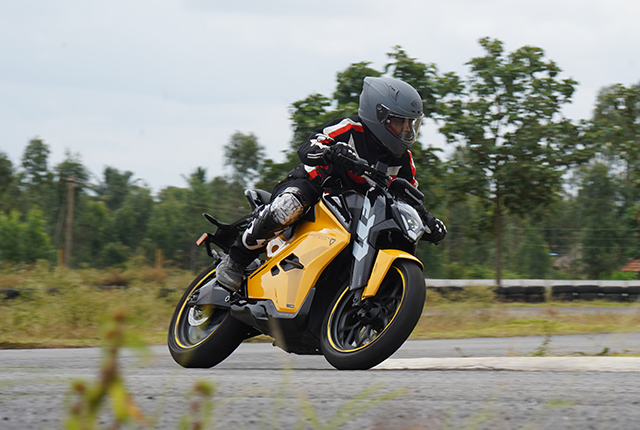Ultraviolette claims to have collected and analysed over 80 lakh kilometres of riding data from consumers, and fine-tuned their firmware accordingly. We took the F77 Mach 2 with the Gen 3 powertrain firmware for a spin to find out what’s new.

Story: Abhisu Poddar
Photography: Kalidas M
Prior to Ultraviolette’s much anticipated entry into the European market, the Bengaluru-based EV startup felt the need to carry out some serious due diligence before they felt their products were ready for a silent takeover of the European roads. With no viable electric sportbike option around the 9,000 Euro mark, there is a huge void waiting to be filled by Ultraviolette’s entry into the sphere.
During a conversation regarding the firmware update, Ultraviolette CEO Narain Subramanium pointed out the stark difference between the highway riding characteristics of motorcyclists in Europe and India. While Indian riders demand more acceleration and have a more variable throttle input thanks to our country’s stop-and-go traffic conditions, European riders seek more endurance at higher speeds – with their expansive highway infrastructure, a lot of their riding time is spent with the throttle jammed wide-open, churning the electric motor at top speed for up to 30 minutes at a time. This extensive high speed, high endurance running requirement meant that Ultraviolette found the need to optimize the way their power is delivered and thermal efficiency is contained.
The changes, then. Ultraviolette had brought both the older and the newer version for the media to sample, so confident were they of the tangible upgrades they’ve made. We first took a pre-update Mach 2 Recon out for five laps to get acquainted with the circuit and re-imprint the nature of the current firmware. Set on Ballistic mode, the power, while bountiful, is delivered in a linear and precise manner. There are no sudden jerks or jumps as you dial the input in progressively, and it’s easy to predict how the sportbike is going to behave from the get-go. It behaves like a docile, yet athletic cat.
Once back at the pits, our bike was swapped with the one armed with the latest update. And boy, was the difference immediately evident as I crawled out of the gravelly pit-exit. This bike just yearns to get going: at the slightest input, it rears its head up, ready to pounce. The accelerator is now a lot more sensitive; in fact, the input is now so snappy, it took me two more laps to recalibrate myself with the aggressive delivery of torque. If the power delivery could be described as a rushing river before, it is a ferocious dam-discharge now. The docile cat has turned into a tiger.
While I loved the new-found militancy of the Ballistic+, a part of me still preferred the linearity and predictability of the older Ballistic mode. Thereupon, came the good news: The old Ballistic mode has now been reassigned as the new Combat mode, meaning one can now have his cake and eat it too.
While the F77 does boast of its explosive acceleration, the 207 kilo heft of the Mach 2 Recon is still evident when crawling or going around sharp corners. However, the low center of gravity and the impeccably tuned chassis mean the bike is a joy to corner at higher speeds. Ergonomically, the Mach 2’s clip-ons are set quite aggressively, positioning us suitably for the track session. People looking to ride it in the city, however, may not be willing to compromise on comfort and convenience for the sake of speed and sportiness; the SuperStreet, with its raised handlebar setup, would be a more utilitarian option to traverse downtown with.
Regardless, the Ultraviolette F77 is an avant-garde electric motorcycle. Lusciously designed and built equally well, it’s heartwarming witnessing an indigenous product make a mark on a global scale. Ultraviolette is a positive example of what a bunch of motivated Indians can accomplish with a common goal in mind. We don’t have the dearth of knowledge and manpower, after all.
Also Read: TVS Apache RTR 310 Review


Leave a Reply